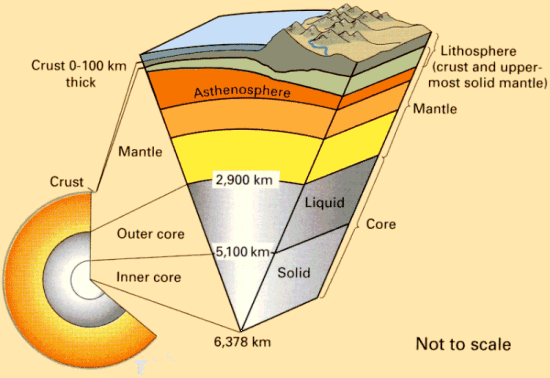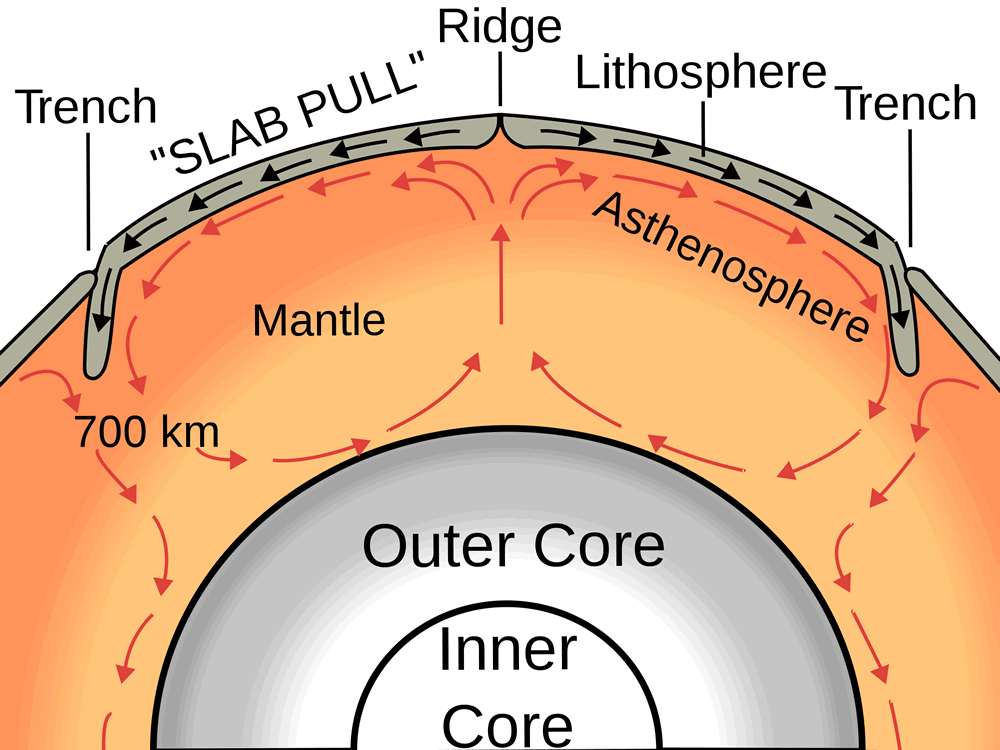Alfred Wegener

Alfred Wegener pictured, (winter 1912/1913),
during his second expedition to Greenland.
In 1906 Wegener had joined an expedition to Greenland to study polar air circulation.
The first concept of continental drift first came to me as far back as 1910, when considering the map of the world, under the direct impression produced by the congruence of the coastlines on either side of the Atlantic. At first I did not pay attention to the idea because I regarded it as improbable.
Alfred Wegener
Alfred Wegener
The hypothesis that the continents had once formed a single landmass, called Pangaea, (a term derived from ancient Greek, meaning "all lands" or "all the Earth"), before breaking apart and drifting to their present locations was first presented by Alfred Wegener to the German Geological Society on 6 January 1912.
Although Wegener's theory was formed independently and was more complete than those of his predecessors, Wegener later credited a number of past authors with similar ideas.

Contemporary understanding of Continental Drift
Pangaea to present
Source=This Dynamic Earth: The Story of Plate Tectonics. (Online ed.). Reston, Virgina, USA: United States Geological Survey.
While at Marburg, in the autumn of 1911, Wegener was browsing in the university library when he came across a scientific paper that listed fossils of identical plants and animals found on opposite sides of the Atlantic. Intrigued by this information, Wegener began to look for, and find, more cases of similar organisms separated by great oceans. Orthodox science at the time explained such cases by postulating that land bridges, now sunken, had once connected far-flung continents. But Wegener noticed the close fit between the coastlines of Africa and South America. Might the similarities among organisms be due, not to land bridges, but to the continents having been joined together at one time? As he later wrote: "A conviction of the fundamental soundness of the idea took root in my mind."

Continental Drift and the Fossil record
(later work-up by the U.S. Geological Survey)
Such an insight, to be accepted, would require large amounts of supporting evidence. Wegener found that large-scale geological features on separated continents often matched very closely when the continents were brought together. For example, the Appalachian mountains of eastern North America matched with the Scottish Highlands, and the distinctive rock strata of the Karroo system of South Africa were identical to those of the Santa Catarina system in Brazil. Wegener also found that the fossils found in a certain place often indicated a climate utterly different from the climate of today: for example, fossils of tropical plants, such as ferns and cycads, are found today on the Arctic island of Spitsbergen.
Part of the problem was that Wegener had no convincing mechanism for how the continents might move. Wegener thought that the continents were moving through the earth's crust, like icebreakers plowing through ice sheets, and that centrifugal and tidal forces were responsible for moving the continents.
In 1915 the first edition of The Origin of Continents and Oceans, a book outlining Wegener's theory, was published in Germany.
In Britain, in January 1923, the year after the first English translation of, (incidentally, a later edition), of Wegener’s The Origin of Continents and Oceans, a British geologist and palaeontologist named Philip Lake said this about Wegener at a meeting of the Royal Geographical Society:
"He is not seeking the truth; he is advocating a cause, and is blind to every fact and argument that tells against it. It is easy to fit the pieces of a puzzle together if you distort their shape, but when you have done so, your success is no proof that you have placed them in their original positions. It is not even a proof that the pieces belong to the same puzzle or that all the pieces are present."
Alfred Wegener died in Greenland in November, 1930.
Following Wegener, only a handful of geologists were willing to inherit the orphaned continental drift theory. Arthur Holmes, Alexander du Toit, and Reginald Daly spring to mind. They all believed the data and accepted the theory, but they each had busy jobs as geologists – proving drift theory was an interest, but neither an occupation nor obsession. Drift theory did not take a complete hiatus, but the years between 1930 and 1955 saw very few converts to the cause.
The British geologist Arthur Holmes supported the theory of continental drift at a time when it was deeply unfashionable. He proposed that the Earth's mantle contained convection cells that dissipated radioactive heat and moved the crust at the surface. His Principles of Physical Geology, ending with a chapter on continental drift, was published in 1944.
The Theory of Plate Tectonics or Continental Drift was not accepted for many years largely due to there not being any credible explanation available of a driving force that would be necessary for powering the movement of land masses that were Continental in scale and which could only be thought of as being of truly immense weight.
The well-known TV presenter of Natural History shows, David Attenborough, who attended Cambridge University in the second half of the 1940s, recounted an incident illustrating its lack of acceptance then:
"I once asked one of my lecturers why he was not talking to us about continental drift and I was told, sneeringly, that if I could prove there was a force that could move continents,
then he might think about it. The idea was moonshine, I was informed."
McKie, Robin (28 October 2012). "David Attenborough: force of nature". The Observer (London).
McKie, Robin (28 October 2012). "David Attenborough: force of nature". The Observer (London).
What prompted the revival of continental drift? In large part it was increased exploration of the Earth's crust, notably the ocean floor, beginning in the 1950s and continuing on to the present day.
Magnetic Polarity on the Same Continent with Rocks of Different Ages
Puzzling new evidence came in the 1950s from studies on the Earth’s magnetic history. Scientists used magnetometers, devices capable of measuring the magnetic field intensity, to look at the magnetic properties of rocks in many locations. Geologists noted important things about the magnetic polarity of different aged rocks on the same continent. Magnetite crystals in fresh volcanic rocks point to the current magnetic north pole no matter what continent or where on the continent the rocks are located. Older rocks that are the same age and are located on the same continent point to the same location, but that location is not the current north magnetic pole. Older rock that are of different ages do not point to the same locations or to the current magnetic north pole.In other words, although the magnetite crystals were pointing to the magnetic north pole, the location of the pole seemed to wander. Scientists were amazed to find that the north magnetic pole changed location through time. There are three possible explanations for this: 1) The continents remained fixed and the north magnetic pole moved. 2) The north magnetic pole stood still and the continents moved, or 3) both the continents and the north pole moved.
By the 1960s, scientists had amassed enough evidence to support the missing mechanism—namely, seafloor spreading—for Wegener’s hypothesis of continental drift to be accepted as the theory of plate tectonics.
By the late 1960s, plate tectonics was well supported and accepted by almost all geologists. We now know that Wegener's theory was wrong in one major point: continents do not plow through the ocean floor. Instead, both continents and ocean floor form solid plates, which "float" on the asthenosphere, the underlying rock that is under such tremendous heat and pressure that it behaves as an extremely viscous liquid. (Incidentally, this is why the older term "continental drift" is not quite accurate -- both continents and oceanic crust move.)
Puzzling new evidence came in the 1950s from studies on the Earth’s magnetic history. Scientists used magnetometers, devices capable of measuring the magnetic field intensity, to look at the magnetic properties of rocks in many locations. Geologists noted important things about the magnetic polarity of different aged rocks on the same continent. Magnetite crystals in fresh volcanic rocks point to the current magnetic north pole no matter what continent or where on the continent the rocks are located. Older rocks that are the same age and are located on the same continent point to the same location, but that location is not the current north magnetic pole. Older rock that are of different ages do not point to the same locations or to the current magnetic north pole.In other words, although the magnetite crystals were pointing to the magnetic north pole, the location of the pole seemed to wander. Scientists were amazed to find that the north magnetic pole changed location through time. There are three possible explanations for this: 1) The continents remained fixed and the north magnetic pole moved. 2) The north magnetic pole stood still and the continents moved, or 3) both the continents and the north pole moved.
By the 1960s, scientists had amassed enough evidence to support the missing mechanism—namely, seafloor spreading—for Wegener’s hypothesis of continental drift to be accepted as the theory of plate tectonics.
By the late 1960s, plate tectonics was well supported and accepted by almost all geologists. We now know that Wegener's theory was wrong in one major point: continents do not plow through the ocean floor. Instead, both continents and ocean floor form solid plates, which "float" on the asthenosphere, the underlying rock that is under such tremendous heat and pressure that it behaves as an extremely viscous liquid. (Incidentally, this is why the older term "continental drift" is not quite accurate -- both continents and oceanic crust move.)
By the 1960s science had become generally accepting of a theory of Plate Tectonics where the "solid plates" of a so-called Lithosphere - be they continents or ocean floor - effectively "floated" on a so-called Asthenosphere, of underlying rock that is under such high pressure and temperature conditions as to permit slight flows of movement that over geological timescales have had a cumulative effect that has distinctly shaped our planet.
Structure of the Earth

The structure of the Earth is summarized in this diagram.
Please note, however, that the thickness of the layers is not to scale. For example, the crust is much thinner than shown in this diagram! Also remember that the lithosphere-asthenosphere boundary is really a gradual transition, not a sharp break in material behavior.
It is now believed that, as heat rises, so hotter materials also rise from within the Earth's Mantle into the Asthenosphere displacing cooler materials and generating collosal 'flows' under the Earth's crust.
The Earth's crust is held to be subject to movement because of forces associated with those collosal flows.
Oceanic spreading due to currents in the Earth's Mantle and Asthenosphere.

It is today accepted that the Earth's crust is comprise of 'plates' which move, and as a result can drift away from, collide with, or shift laterally 'sliding against', other plates.

The above image shows fifteen of the main tectonic plates and their boundaries.
The red arrows show the direction of drift at the plate boundaries.
(N.B. Some sources continue to show the Indian and Australian plates featured here as a single Indo-Australian plate.)
The fact that large portions of the ocean floor, as well as continental expanses, seem to be "solid plates" has tended to discredit the term - Continental Drift hypothesis - and to establish the alternative, settled, view - i.e. Plate Tectonics.
Another truly momentous theory


Human Being seems
to be rather "Tripartite"

It seems possible that such Human-innate
"bundles of relations and knots of roots"
tend to give rise to the "World" of Human Societies!!!
"Non-Doctrinaire" Human Societies often
seem to be rather "Tripartite"


